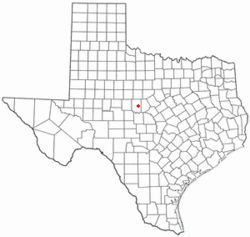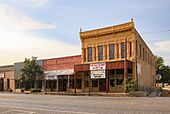Santa Anna, Texas facts for kids
Quick facts for kids
Santa Anna, Texas
|
|
|---|---|

Downtown Santa Anna
|
|

Location of Santa Anna, Texas
|
|
| Country | United States |
| State | Texas |
| County | Coleman |
| Area | |
| • Total | 1.99 sq mi (5.16 km2) |
| • Land | 1.99 sq mi (5.16 km2) |
| • Water | 0.00 sq mi (0.00 km2) |
| Elevation | 1,723 ft (525 m) |
| Population
(2020)
|
|
| • Total | 1,014 |
| • Density | 509.5/sq mi (196.51/km2) |
| Time zone | UTC-6 (Central (CST)) |
| • Summer (DST) | UTC-5 (CDT) |
| ZIP code |
76878
|
| Area code(s) | 325 |
| FIPS code | 48-65672 |
| GNIS feature ID | 2413258 |
Santa Anna is a small town located in Coleman County, in Central Texas, United States. In 2020, about 1,014 people lived there.
Contents
Exploring Santa Anna's Location
Santa Anna is in the eastern part of Coleman County. Three major U.S. highways run through the town center.
- U.S. Route 283 goes south about 44 miles to Brady.
- U.S. Route 67 goes west about 39 miles to Ballinger.
- U.S. Route 84 and US 283 together go northwest about 9 miles to Coleman, which is the main city of the county.
- US 67 and 84 together go east about 21 miles to Brownwood.
The town covers an area of about 5.2 square kilometers (2 square miles). All of this area is land.
Santa Anna's Climate
The weather in Santa Anna has hot, humid summers. Winters are usually mild to cool. This type of weather is called a humid subtropical climate.
A Look at Santa Anna's History
The two tall, flat-topped mountains in central Coleman County have always been easy to spot. An old map of Texas even shows a mountain near the state's center called "Santa Anna's Peaks." Both the mountain and later the town were named after a Comanche war chief named Santanna, or Santa Anna.
Early Days and Settlement
Texas Rangers used to camp at the base of the mountain long before people settled there. Cattle were driven from South Texas to northern markets, passing through a gap in the mountain. This route was a military road that helped supply forts along the Texas Forts Trail.
The first European-American settlers built their homes near a fresh water spring at the mountain's base. One smart settler started the first business in the early 1870s. He sold supplies to trail drivers and settlers at "The Gap." In 1879, people asked to open a post office, and they chose the name "Santa Anna."
Growth and Development
When the Santa Fe Railroad was being built, some residents bought land along the railway. Buildings were made from limestone taken from the nearby mountain. Several businesses moved from other towns to be part of this new community.
In 1886, the local newspaper, The Santa Anna News, was started. The first telephone in the county was a private line from Brownwood to Coleman. It was connected in the Melton Hotel in Santa Anna. A small local phone service began in 1892. A drugstore and a bank opened in the 1880s. A small one-room school quickly grew to four rooms.
Farming, Ranching, and Business
As open lands were claimed and sold, people started farming. Cotton became the main crop. Santa Anna eventually had four cotton gins, which separated cotton fibers from seeds. It was also a major place for shipping livestock by train.
The town became a busy trade center. It had many businesses, including drugstores, hotels, banks, and places to keep horses. One old building, still a landmark today, had an opera house. Here, traveling groups and local people put on shows.
After World War I, Dr. T.R. Sealy opened a hospital that became very well known. In the 1920s, a nursing school was started there to train nurses. It continued until Dr. Sealy passed away in the mid-1930s.
For the first half of the 20th century, Santa Anna was a busy farming and ranching town. Later, businesses related to the oil industry also grew there.
Santa Anna Today: Tourism and Local Businesses
Since the early 2000s, tourism has become a new industry in Santa Anna. Currently, there are 38 businesses in Santa Anna, with 13 of them being less than three years old.
- Custom hand-crafted furniture is a special feature of the town.
- Many antique stores, furniture stores, and unique shops attract visitors.
- Santa Anna and the surrounding area are also popular for hunting dove, quail, turkey, and deer.
Understanding Santa Anna's Population
| Historical population | |||
|---|---|---|---|
| Census | Pop. | %± | |
| 1890 | 468 | — | |
| 1910 | 1,453 | — | |
| 1920 | 1,407 | −3.2% | |
| 1930 | 1,883 | 33.8% | |
| 1940 | 1,661 | −11.8% | |
| 1950 | 1,605 | −3.4% | |
| 1960 | 1,320 | −17.8% | |
| 1970 | 1,310 | −0.8% | |
| 1980 | 1,535 | 17.2% | |
| 1990 | 1,249 | −18.6% | |
| 2000 | 1,081 | −13.5% | |
| 2010 | 1,099 | 1.7% | |
| 2020 | 1,014 | −7.7% | |
| U.S. Decennial Census | |||
2020 Census Information
| Race | Number | Percentage |
|---|---|---|
| White (NH) | 714 | 70.41% |
| Black or African American (NH) | 37 | 3.65% |
| Native American or Alaska Native (NH) | 1 | 0.1% |
| Asian (NH) | 1 | 0.1% |
| Some Other Race (NH) | 2 | 0.2% |
| Mixed/Multi-Racial (NH) | 46 | 4.54% |
| Hispanic or Latino | 213 | 21.01% |
| Total | 1,014 |
In 2020, there were 1,014 people living in Santa Anna. There were 405 households and 268 families in the town.
Education in Santa Anna
The Santa Anna Independent School District provides education for the town's students.
Famous People from Santa Anna
- Louis Crump, a Texas state senator
- Bobby Layne, a famous football quarterback who is in the Pro Football Hall of Fame
Gallery
See also
 In Spanish: Santa Anna (condado de Coleman, Texas) para niños
In Spanish: Santa Anna (condado de Coleman, Texas) para niños





